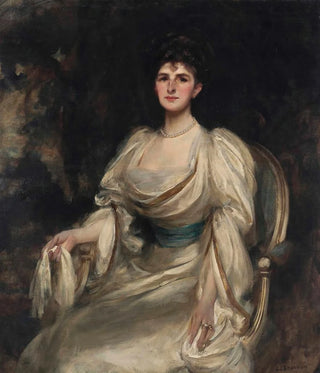Art print | Mme George Harland-Peck - James Jebusa Shannon


View from behind

Frame (optional)
In the vast panorama of art history, certain works stand out for their ability to capture the essence of an era and reveal the depth of the human soul. The art print of "Mme George Harland-Peck" by James Jebusa Shannon is a perfect example. This painting, both intimate and majestic, immerses us in the universe of the late 19th century, where the British portraitist excels at immortalizing the beauty and personality of her subjects. Through this piece, Shannon invites us to explore not only the face of his muse but also the emotions and stories hidden behind each gaze.
Style and uniqueness of the work
James Jebusa Shannon's style is characterized by finesse of execution and meticulous attention to detail. In "Mme George Harland-Peck," the chiaroscuro technique is skillfully used to create an atmosphere that is both soft and dramatic. The subtle nuances of colors, ranging from warm tones to delicate shadows, give the composition striking depth. The model's posture, both confident and delicate, demonstrates Shannon's mastery in portrait art. Every element of the work, from the drapes of the dress to the light reflections on the skin, is carefully thought out to convey a palpable reality. This attention to detail, combined with a keen sense of composition, makes this work an emblematic example of modern portraiture of its time.
The artist and his influence
James Jebusa Shannon, born in 1862, is a significant figure in the British artistic movement. Trained at the Royal Academy, he established himself as a renowned portraitist, capturing the faces of aristocracy and high society of his era. His innovative approach, blending realism and impressionism, influenced many contemporary artists and paved the way for new techniques in portrait representation. Shannon does not merely reproduce the appearance of his subjects; he strives to transmit their essence, character, and story. Through his works, he offers us a unique perspective on Victorian society, while laying the foundations for an art that would continue to evolve into the 20th century.

Matte finish

View from behind

Frame (optional)
In the vast panorama of art history, certain works stand out for their ability to capture the essence of an era and reveal the depth of the human soul. The art print of "Mme George Harland-Peck" by James Jebusa Shannon is a perfect example. This painting, both intimate and majestic, immerses us in the universe of the late 19th century, where the British portraitist excels at immortalizing the beauty and personality of her subjects. Through this piece, Shannon invites us to explore not only the face of his muse but also the emotions and stories hidden behind each gaze.
Style and uniqueness of the work
James Jebusa Shannon's style is characterized by finesse of execution and meticulous attention to detail. In "Mme George Harland-Peck," the chiaroscuro technique is skillfully used to create an atmosphere that is both soft and dramatic. The subtle nuances of colors, ranging from warm tones to delicate shadows, give the composition striking depth. The model's posture, both confident and delicate, demonstrates Shannon's mastery in portrait art. Every element of the work, from the drapes of the dress to the light reflections on the skin, is carefully thought out to convey a palpable reality. This attention to detail, combined with a keen sense of composition, makes this work an emblematic example of modern portraiture of its time.
The artist and his influence
James Jebusa Shannon, born in 1862, is a significant figure in the British artistic movement. Trained at the Royal Academy, he established himself as a renowned portraitist, capturing the faces of aristocracy and high society of his era. His innovative approach, blending realism and impressionism, influenced many contemporary artists and paved the way for new techniques in portrait representation. Shannon does not merely reproduce the appearance of his subjects; he strives to transmit their essence, character, and story. Through his works, he offers us a unique perspective on Victorian society, while laying the foundations for an art that would continue to evolve into the 20th century.






